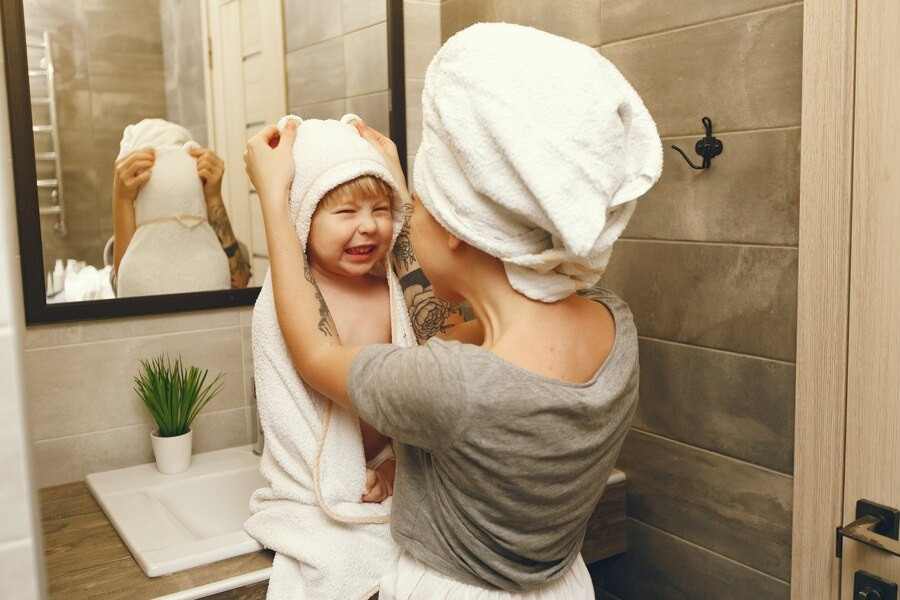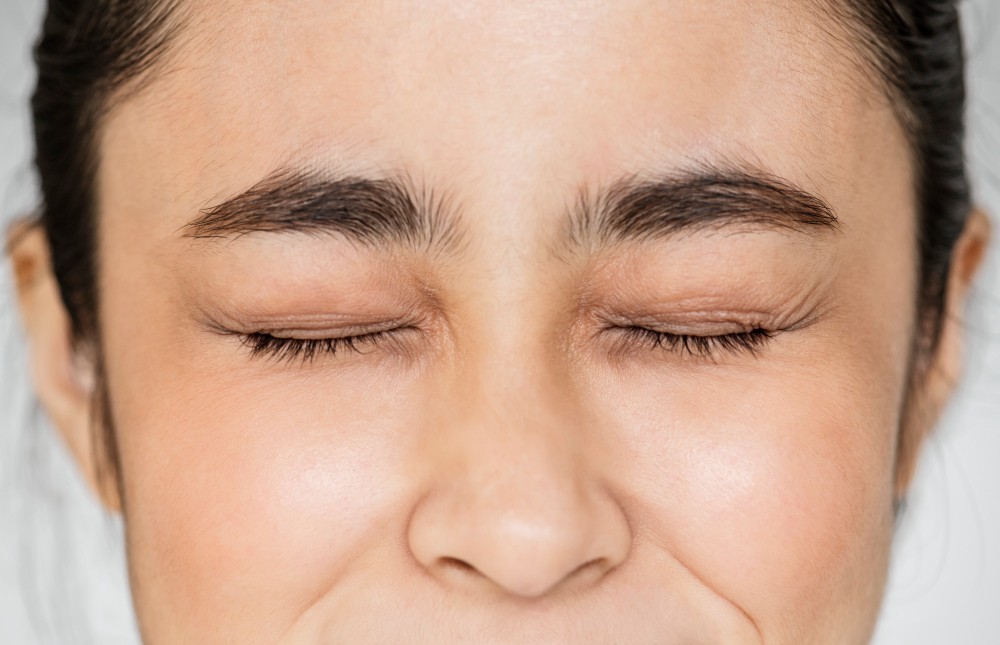Eksim pada anak-anak juga dikenal dengan istilah dermatitis atopik. Ini adalah kondisi kronis di mana kulit mengalami peradangan dan iritasi. Dengan eksim, maka kulit anak-anak akan mengalami ruam kemerahan, gatal, bersisik, dan kulit kering.
Pemicu utama eksim adalah kulit kering, iritasi, stres, alergi, infeksi, cuaca yang panas atau keringat. Walaupun bukan kondisi yang mengancam jiwa, apabila kulit dengan eksim mengalami infeksi yang parah maka akan menimbulkan bahaya bagi kesehatan anak.
Cara Merawat Eksim pada Anak-Anak
Eksim bukanlah kondisi yang dapat disembuhkan. Maka untuk mengelola gejalanya, Anda perlu memberikan pengobatan rutin dan juga perawatan yang memadai.
Berikut adalah panduan merawat eksim pada anak-anak, di antaranya:
Mandi dengan suhu yang tepat
Anak dengan eksim perlu mandi dengan air hangat dan menghindari air yang terlalu panas. Air yang terlalu panas dapat menghilangkan minyak alami dari kulit yang justru membuat kulit makin kering dan lebih mudah iritasi.
Mandi singkat dengan air hangat, sekiar 10-15 menit juga meminimalkan risiko iritasi, membantu menjaga keseimbangan kulit yang sehat serta menjaga kulit tetap bersih.
Penggunaan pelembap
Penggunaan pelembap secara teratur membantu menjaga kelembapan kulit dengan membentuk lapisan pelindung di atas kulit yang mencegah kehilangan air. Ini sangat penting karena kulit anak dengan eksim cenderung lebih kering dan rentan kehilangan kelembapan.
Kekeringan kulit dapat memperburuk gejala eksim termasuk rasa gatal dan peradangan. Penting untuk memilih pelembap yang cocok untuk jenis kulit sensitif dan tidak mengandung bahan-bahan yang dapat menyebabkan iritasi tambahan. Untuk jenis kulit dengan eksim, Anda bisa memilih pelembap berbahan aloe vera atau oatmeal serta hindari pelembap yang mengandung pewangi atau bahan kimia yang sangat keras.
Baca Juga: Polusi Udara Ternyata Dapat Menyebabkan Gatal Eksim
Mengatur suhu ruangan
Mengatur suhu ruangan yang nyaman dan menjaga kelembapan adalah salah satu hal penting yang perlu dilakukan untuk merawat kulit dengan eksim. Udara yang kering dapat menyebabkan kulit menjadi lebih kering dan rentan terhadap gejala eksim. Udara yang kering juga menyebabkan iritasi pada kulit anak yang sensitif.
Sebaliknya, lingkungan yang lembap dapat membantu mempercepat pemulihan kulit yang rusak akibat eksim. Anda bisa menjaga suhu yang nyaman dan menggunakan alat seperti humidifier untuk menjaga kelembapan ruangan.
Memilih pakaian berbahan katun
Pakaian berbahan katun menjadi pilihan yang lebih baik untuk anak dengan eksim dibandingkan dengan bahan sintesis atau wol. Bahan katun cenderung lembut dan nyaman di kulit anak, terutama kulit sensitif akibat eksim.
Bahan katun juga memiliki sifat lebih bernapas sehingga memungkinkan udara dan kelembapan bergerak bebas. Ini dapat membantu menjaga kulit tetap kering dan mencegah kelembapan berlebih yang juga dapat menyebabkan iritasi.
Bahan katun juga mampu menyerap keringat dengan baik, mencegah reaksi alergi serta mudah dicuci dan dipelihara.
Baca Juga: Perbedaan Antara Eksim dan Psoriasis
Pemilihan deterjen
Deterjen yang mengandung pewangi atau bahan kimia tertentu dapat menyebabkan iritasi pada kulit sensitif khususnya anak dengan eksim. Reaksi alergi atau iritasi dari deterjen dapat memperburuk gejala eksim seperti rasa gatal dan kemerahan.
Untuk mempertahankan kualitas pakaian dan tidak menyebabkan gejala alergi atau eksim, sebaiknya pilih deterjen yang lembut dan bebas pewangi.
Mencegah menggaruk kulit
Rasa gatal cenderung memancing anak untuk menggaruk kulit. Namun, menggaruk kulit yang iritasi justru dapat menyebabkan kulit memiliki luka terbuka dan meningkatkan risiko infeksi. Alihkan perhatian anak dari rasa gatal dengan kegiatan lain seperti membaca buku, menonton film, bermain, atau melakukan aktivitas lain yang disukai anak.
Anda juga bisa membantu mengurangi rasa gatal dengan memberikan kompres dingin, atau gel pelembap yang dapat mengurangi rasa gatal.
Apabila rasa gatal yang dialami anak-anak akibat gejala eksim terlalu parah atau tidak merespons pengobatan rumahan, konsultasikan dengan dokter anak atau dokter kulit untuk mendapatkan rekomendasi pengobatan serta perawatan lebih lanjut. Anda juga bisa memanfaatkan layanan konsultasi kesehatan dengan mengunduh aplikasi Ai Care melalui App Store atau Play Store.
Mau tahu informasi seputar kehamilan, menyusui, kesehatan wanita dan anak-anak? Cek di sini, ya!
- dr. Monica Salim
Cleveland Clinic (2022). Eczema. Available from: https://my.clevelandclinic.org/health/diseases/9998-eczema
Mayo Clinic (2023). Atopic dermatitis (eczema). Available from: https://www.mayoclinic.org/diseases-conditions/atopic-dermatitis-eczema/symptoms-causes/syc-20353273
Boston Children's Hospital. Eczema. Available from: https://www.childrenshospital.org/conditions/eczema
Leslie Barrie (2022). The Right Way to Take a Shower or Bath When You’re Managing Eczema. Available from: https://www.everydayhealth.com/eczema/shower-tips-to-soothe-your-eczema.aspx
Vincent Iannelli, MD (2023). Dry Skin Treatments for Babies and Older Children. Available from: https://www.verywellhealth.com/childrens-dry-skin-pediatric-dermatology-2633476
Camerin Spahn (2021). 11 Tips to Prevent Dry Winter Skin. Available from: https://www.healthline.com/health/winter-dry-skin
Kristeen Moore (2022). Humidifiers and Health. Available from: https://www.healthline.com/health/humidifiers-and-health
Rachel Reiff (2023). Clothes Tips for Eczema. Available from: https://www.webmd.com/skin-problems-and-treatments/eczema/ss/slideshow-clothes-for-eczema
Leslie Barrie (2024). 8 Laundry Tips for People With Eczema. Available from: https://www.everydayhealth.com/news/are-your-clean-clothes-drying-your-skin/
Mayo Clinic (2024). Itchy skin (pruritus). Available from: https://www.mayoclinic.org/diseases-conditions/itchy-skin/diagnosis-treatment/drc-20355010











